
While Mandanna’s video may have stirred up a storm on social media, deepfakes are not a new phenomenon. During the Covid-19-induced lockdowns, a TikToker known as Miles Fisher, who is also a look-alike of Hollywood superstar Tom Cruise, fooled millions of users with his deepfake videos of the popular star. Back then, videos of Cruise playing guitar, Golf, or simply following TikTok trends spread like wildfire on social media. While it may be difficult to discern fact from fiction, here are some telltale signs of a deepfake video.
Spotting a deep fake
With technology improving rapidly, it has become difficult to tell real from fake images.
Look at the eyes: Research published in 2018 claimed that deepfake faces don’t blink like the way normal humans do. However, in the Mandanna video, one could see that she blinks twice. Yet, noticeably, the eyes look different. Eyes can reveal a lot more if observed closely.
Read the lips: Deepfakes, often of poor quality, are easy to spot, mainly because of bad lip-syncing. Look at the way the lips move based on the audio. Deepfake videos may show some anomalies.
Skin: The skin tone of the real person can give away the fake one. Deepfake videos often show blemishless skin, or even the tone can be patchy. Also, strange body movements could be one of the signs.
Story continues below this ad
The hair and teeth: Hair contains finer details, making it difficult for deep fake software to render well. Look for the strands on the fringe; the hair may just help you decode the video. Sometimes, teeth too can be a big giveaway as they may not appear as natural as they should.
Look for the jewellery: If the person is wearing jewellery, then chances are high that they may look unusual owing to the lighting effects.
So what exactly is a deepfake?
It is in essence, a program that is based on a form of artificial intelligence known as deep learning, which is used to make images and videos of fake events. With deepfake technology, anyone can make a politician, celebrity or popular athlete parrot any lines. One can make their favourite or not-so-favourite stars dance to their tunes, quite literally.
Deepfakes are synthetic media that are made using artificial production, modification, or manipulation of images, videos, or audio with the help of AI. The technology may come with positive use cases, such as in the field of movies for visual effects, in Augmented Reality to create avatars for an assortment of services, social media activities, education, and more. Unfortunately, ever since they surfaced, they have been mostly used for political misinformation, revenge porn, fake celebrity, and committing fraud to dupe unsuspecting consumers.
Story continues below this ad
The rapid proliferation of deepfake technology is also credited to the new techniques being introduced at a rapid pace. This lets anyone with barely passable editing skills make these videos with relative ease. It is to be noted that deepfakes are not just for videos, they can be used to manipulate audio too.
How are deepfakes created?
The algorithm traces similarities between the faces and later brings them down to their commonly shared features. Different sets of decoders are trained on both faces. In order to create the deepfake, the creator simply needs to swap the faces from their respective decoders. To make it simple, a compressed image of person X is fed into the decoder which is trained on person Y. The decoder later restructures the face of X based on the expressions of Y.
To make this look convincing, one would have to do the same process frame by frame. There is also another way to make deepfakes with a method known as generative adversarial networks or Gan which yokes two AI algorithms to produce the outcome.









